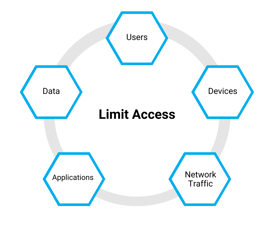
Endpoint encryption protects data on laptops, desktops, mobile devices, and servers from unauthorized access, even if the device is lost or stolen. Businesses must implement encryption to safeguard sensitive data like customer information, financial data, and intellectual property, as compromising this data can have severe consequences such as financial losses, reputational damage, and legal liability.
What Defines Encryption Best Practices?
Data encryption best practices are the steps that organizations of all sizes can take to protect their sensitive data from unauthorized access. Database encryption best practices are a subset of data encryption best practices that focus specifically on protecting database data.
Use Strong Encryption Algorithms
The first step to encrypting your data is to choose a strong encryption algorithm. Encryption algorithms are mathematical formulas that are used to scramble data so that it cannot be read by unauthorized users. Some of the most common encryption algorithms include AES, RSA, and ECC.
When choosing an encryption algorithm, it is important to consider the following factors:
- Security: The algorithm should be strong enough to resist known attacks.
- Performance: The algorithm should be fast enough to encrypt and decrypt your data without causing any noticeable performance overhead.
- Compatibility: The algorithm should be compatible with the software and hardware that you are using.
Charles IT account manager, Tom Tetrault, explains the importance of encryption for SMBs:
.png?width=900&height=300&name=Why%20is%20endpoint%20encryption%20so%20important%20for%20SMBs%20(1).png)
Manage Your Encryption Keys Carefully
Encryption keys are the passwords or codes that are used to encrypt and decrypt data. It is important to manage your encryption keys carefully to ensure that they remain secure.
Here are some essential practices to effectively manage your encryption keys:
- Use strong encryption keys. Encryption keys should be at least 12 characters long and include a mix of upper and lowercase letters, numbers, and symbols.
- Store your encryption keys in a secure location. Encryption keys should be stored in a location that is inaccessible to unauthorized users.
- Back up your encryption keys. Encryption keys should be backed up regularly in case they are lost or corrupted.
Encrypt All Sensitive Data
It is important to encrypt all sensitive data, regardless of where it is stored. This includes data that is stored on your computers, laptops, mobile devices, servers, and in the cloud.
Here are some essential practices to ensure the encryption of all sensitive data:
- Use full-disk encryption to encrypt all data on your computers and laptops.
- Use encryption software to encrypt sensitive data files and folders.
- Use cloud encryption to encrypt data that is stored in the cloud.
Implement an Access Policy
Implementing an access policy is an essential security measure that restricts user access to data and systems based on their specific job responsibilities. An example of this on a broader scale is the ideology of the 'Zero Trust' security strategy - this limits organizations to have the least possible access in order to complete tasks within the network. It ensures that not everyone has access to everything, and only certain individuals can access specific areas of your network.
user access to data and systems based on their specific job responsibilities. An example of this on a broader scale is the ideology of the 'Zero Trust' security strategy - this limits organizations to have the least possible access in order to complete tasks within the network. It ensures that not everyone has access to everything, and only certain individuals can access specific areas of your network.
By only granting access to the necessary data and systems, organizations can significantly minimize the risk of unauthorized access to sensitive information.
Keep Your Software and Hardware Up to Date
Software and hardware vendors regularly release security updates to patch vulnerabilities. It is important to install these updates promptly to protect your data from known attacks.
Here are some tips for keeping your software and hardware up to date:
- Enable automatic updates for your software and hardware.
- Check for updates regularly, even if automatic updates are enabled.
- Install updates as soon as they are available.
Important Factors To Consider
Collaboration with Stakeholders
It is important to collaborate with stakeholders when implementing encryption best practices. Stakeholders may include employees, management, IT staff, and customers.
Collaboration can help to ensure that everyone is aware of the encryption best practices that are in place and that everyone is on the same page about how to implement and enforce them.
Discovering and Remediating Vulnerabilities Promptly
It is important to discover and remediate vulnerabilities promptly. Vulnerabilities can be exploited by attackers to gain unauthorized access to sensitive data.
There are a number of tools and services that can be used to discover vulnerabilities. Once vulnerabilities have been discovered, it is important to remediate them as soon as possible.
A Focus on Policies and How to Enforce Them
It is important to have policies in place that govern the use of encryption. These policies should cover topics such as:
- What data should be encrypted?
- What encryption algorithms should be used?
- How should encryption keys be managed?
- Who should have access to encryption keys?
It is also important to have a plan for enforcing these policies. This may involve training employees on the policies and monitoring compliance with the policies.
Using Proven Technology
It is important to use proven encryption technology. Proven encryption technology has been tested and evaluated by security experts to ensure that it is effective.
There are a number of proven encryption technologies available, such as full-disk encryption, file encryption, and cloud encryption.
The Importance of Maintenance and Updates
It is important to maintain and update your encryption systems. This includes regularly backing up your encryption keys and installing security updates for your encryption software and hardware.
Maintaining and updating your encryption systems will help to ensure that they remain effective at protecting your data.
Tools for Data Recovery
Even with the best encryption practices in place, there is always a small chance that data could be lost or corrupted. In the event that data is lost or corrupted, it is important to have tools in place to recover it.
There are a number of data recovery tools available. Some of these tools are designed to recover data from specific types of storage devices, such as hard drives, solid state drives, and USB drives. Other data recovery tools are designed to recover specific types of data, such as photos, videos, and documents.
When choosing a data recovery tool, it is important to consider the following factors:
- The type of storage device that the data was stored on
- The type of data that was lost or corrupted
- Your budget
Final Thoughts
Implementing strong encryption practices is crucial in safeguarding your sensitive data from unauthorized access. By following these encryption best practices, you can effectively protect your valuable information. If you're looking to discuss implementing best-in-class encryption for your organization, click the button below to talk with our experts!

.png)


